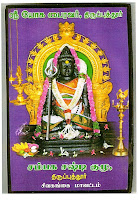Visited the following temples
1. Tirukachur
2. Thiru idai chooram
3. Sembakkam Jambukeswarar
4. Sembakkam Guru
Ø Tambaram GST road. Near Maramailnagar station (before ford factory starting), a U turn is there. Take that. MMnagar level crossing will come. Take that road, proceed straight. After 4-5 kms, you will see the temple on the right hand side
Ø The Shiva temple here is is a Thevara Padal petra Sthalam, famous for Girivalam.
Ø Lord Vishnu worshipped Lord Siva in the form of a turtle.
 Ø Sundaramurthy Naayanaar when he reached Tirukaachur, got very tired and was hungry. He sat down. At that time, Lord Siva appeared as a brahmin and went to the village asking everyone for biksha. After that, he gave that food to Sundaramurthy Naayanaar.
Ø Sundaramurthy Naayanaar when he reached Tirukaachur, got very tired and was hungry. He sat down. At that time, Lord Siva appeared as a brahmin and went to the village asking everyone for biksha. After that, he gave that food to Sundaramurthy Naayanaar.Ø These temples were built by Kulothunga chozhan I. During those days, there was no concept of Rajagopuram. The concept of Rajagopuram was introduced by Rajaraja Chozhan’ According to mythology, if you worship here, you will be cured of all ailments(if any).
 Thiru Idai Churam
Thiru Idai ChuramØ Come again to the main road from Tirukachur, proceed straight to Chingleput. Take Chingleput – Tirukazhikundram road, proceed for some time, then take a left turn and ask for Chingleput – Tiruporur road.
Ø We can enjoy the journey, since except road, both side it was nice forest
Ø Devara padal petra sthalam
Ø The village is in a beautiful location between two hills and so the name Idai-churam (churam meaning a place of hills and forests)
 Ø Very big Swayambu Maragatha linga known as Idaichuranathar. You can see the reflection of Arathi. But Gurukal Sankar (Mobile no. 09788705873) said, we can see it crystal clearly the green colour when we perform Honey Abhishegam. Asked us to come on another day, since it was Pradhoksham, the temple was slightly crowded.
Ø Very big Swayambu Maragatha linga known as Idaichuranathar. You can see the reflection of Arathi. But Gurukal Sankar (Mobile no. 09788705873) said, we can see it crystal clearly the green colour when we perform Honey Abhishegam. Asked us to come on another day, since it was Pradhoksham, the temple was slightly crowded.Ø Goddess Parvathi came here as Kamadhenu (cow) with her brother Lord Vishnu and poured milk on the Shivalingam made of Maragatha stone to do the Shiva worship.
Sembakkam Jambukeswarar – ancient
Ø Built by chola kings during 8 / 9th century Ø From T I C, take left, proceed again in Chingleput – Tiruporur road. Approx after 8 kms we will find this temple.
Ø From T I C, take left, proceed again in Chingleput – Tiruporur road. Approx after 8 kms we will find this temple.Ø Even though it was only 6.30 p.m. it was completely dark. Very poor road, with no street lights
Ø The temple is called Vada Thiruvanaika, since the Lord here is present as Jala Swayambu (Swayambu – being present on its own; Jala – water) in the name of Jumbukeswarar

 Ø When Chola King Kochengannan was due for birth, an astrologer informed that if the baby is born late a by few hours, it would rein the whole world. So the mother deliberately delayed the delivery by keeping her legs raised up but died after delivering the baby. Due to this strenuous exercise, the baby was born with red eyes and so was called Chengannan (Chengan means red eyes. Probably slolwly Chengannan might have rechristened as Sembakkam town). Realizing his nature of birth, he became a natural Shiva devotee and later when he was childless, he prayed to Lord Shiva and He told him to make a sacred shivalingam and take it in a ratham (temple car) throughout his regime and wherever the axle of the ratham breaks, install the lingam there and worship to get the boon of a child. So the King did the same and when he neared this place, he became highly excited spiritually and the axle of the ratham broke while crossing the water ditch here. He heard the sacred voice to install the lingam here and thus the King built this temple using mud (bricks) and was blessed with a baby.
Ø When Chola King Kochengannan was due for birth, an astrologer informed that if the baby is born late a by few hours, it would rein the whole world. So the mother deliberately delayed the delivery by keeping her legs raised up but died after delivering the baby. Due to this strenuous exercise, the baby was born with red eyes and so was called Chengannan (Chengan means red eyes. Probably slolwly Chengannan might have rechristened as Sembakkam town). Realizing his nature of birth, he became a natural Shiva devotee and later when he was childless, he prayed to Lord Shiva and He told him to make a sacred shivalingam and take it in a ratham (temple car) throughout his regime and wherever the axle of the ratham breaks, install the lingam there and worship to get the boon of a child. So the King did the same and when he neared this place, he became highly excited spiritually and the axle of the ratham broke while crossing the water ditch here. He heard the sacred voice to install the lingam here and thus the King built this temple using mud (bricks) and was blessed with a baby.Sembakkam Guru
Before proceeding to Jambukeswarar temple itself, we can see this temple in the main road. Construction is under process. Very big and beautiful Guru
We can return to Tambaram via Guduvanchery or proceed to Tiruporur, catch the Kelambakkam road, return to Chennai.
Om Namasivaya




















